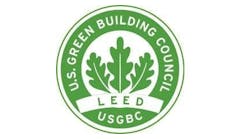There are two truly extraordinary things about Courtyard at Middleburg: the design's ability to seamlessly blend old and new architecture, and the amazing tenacity of the project team. In 2003, the site that would become Courtyard at Middleburg in Middleburg, VA, housed nothing more than a 100-year-old, 2,000-square-foot, 1.5-story bungalow and a small carriage house. By the fall of 2006, the carriage house was nothing but a memory and the historic bungalow (Building A) had been renovated to keep the best of the old building and bring the now-office into the 21st century. Two other buildings (Buildings B and C) were also added to the site and attached via covered walkways.
The project timeline was littered with enough challenges to make novice architects, engineers, and contractors turn and run. Thankfully, project team members had both the skill and persistence to bring the original vision of the developer, Meladon Development Group, to life.
By the time BELLArchitects of Washington, D.C., was enlisted, the project had already faced criticism from review boards. Previous concept designs had been presented to the Town of Middleburg Historic District Review Committee (HDRC) five times and were rejected each time. BELLArchitects created a new concept and, after initial acceptance from the committee, it began readying its plan for the schematic review process. After seven more times before the committee, the long-awaited approval was granted. "There is a great deal of accountability that comes with being in the historic town of Middleburg. We really made a concerted effort to work within HDRC regulations and to produce a magnificent project that complemented the surrounding district," says Rita Canada, president, Meladon Development Group, Ashburn, VA. "After we completed the project, the HDRC changed many of their ordinances."
Getting buy-in from the other four review agencies (the Loudoun County Planning Commission, the Loudoun County zoning reviewer, Loudoun County building permit reviewers, and the Virginia Department of Transportation) made the project especially challenging. "The value of the location is very precious to a lot of people, so there was a lot more scrutiny," says T. David Bell, president, BELLArchitects PC, Washington, D.C.
Designing the new buildings and modernizing the existing bungalow into office space required both strict adherence to zoning regulations and a whole lot of creativity. Since the site could not be subdivided (zoning mandates called for one building per lot), BELLArchitects planned the project as an 11,000-square-foot addition to the existing bungalow (Building A). Though not fully enclosed, the covered walkways allowed Buildings B and C to be defined as additions rather than standalone facilities.
The site is designated as "C-1," a unique zoning category that requires the property on it to be a transition between commercial and residential neighborhoods. It was important that the design of Courtyard at Middleburg be sensitive to the scale, character, massing, styles, and materials of the two distinct areas. The complex of buildings has a very human (vs. monumental) scale, and the exterior façades (complete with double-hung windows, siding, and natural stone) reflect the style of nearby residences. Decision-makers took cues from surrounding buildings and the materials used in those structures.
The half-acre site created its own challenges. According to George Neckar, estimator and project manager with Marshall, VA-based Miller Brothers Inc.: "The buildings almost extended property line to property line." The close proximity to the property line resulted in a very limited area to stage and store material. When Building B was nearly 80-percent complete, it was badly burned by fire (the result of arson). After this unfortunate event, permission was granted to use a nearby vacant lot as storage so it would not encumber the rest of the project.
The density of the site pushed development to the edges of the property, and grading was adjusted to accommodate the existing bungalow. Parking was tucked below grade, under Building C. Any seemingly minor dimensional or elevational change had a ripple effect on the entire project. The ridge height of the project was reduced approximately 3 feet due to zoning requirements. This created real challenges for ceiling and floor-to-floor heights.
Since the constraints for the building envelope and footprint created the need for narrow tolerance, especially floor-to-floor heights, BELLArchitects used 3-D CAD and Building Information Modeling (BIM) software. Structural Insulated Panels (SIPs) were selected to minimize the thickness of the roof structure. The SIPs also eliminated the need for venting and increased the exterior envelope's insulation.
The existing bungalow (Building A) was gutted, the roof was raised, and a whole new roof structure was installed. New HVAC, electrical, and fire-protection systems were also installed. The project would live up to its name when design plans incorporated a courtyard of vegetation. Other green and energy-efficient features of the project included:
- Collection of roof water in gutters that drain to splash blocks rather than directly to storm-sewer piping.
- Site lighting that complies with dark-sky initiatives. Through limited nighttime lighting, careful placement of fixtures, and the use of fixtures with light cutoff shields, the amount of spillover light is reduced.
- Use of products with recycled content (such as cementitious siding, engineered lumber, SIPs, and steel roofing).
- Unpainted stucco, low-VOC paints, and metal roofing with a high-albedo coating.
- High-efficiency HVAC systems.
- Water-conserving toilets.
Courtyard at Middleburg shows no signs of the many challenges it presented during development. The fuel tank that surprised workers during construction was removed and soil was mitigated. Building B was rebuilt after it was set ablaze. And, the abnormally wet weather, while slowing the project, didn't stop construction. "There were many obstacles placed before us, but we pressed on, knowing this project would work," says Canada.
By paying so much attention to the review board's desires, the project is something everyone can be proud of. Bell provides proof: "The mayor of the town lives right across the street and is very pleased with his new neighbor."
Jana J. Madsen ([email protected]) is managing editor at Buildings magazine.
Judges' Comments
"The lengths that the entire team - including the designer, owner, and numerous community organizations and elected officials - went to [in order to] produce such a successful project should be recognized and applauded. The execution of this project was superb. Adaptive reuse and new construction sympathetic to the original design should be welcomed with open arms."

